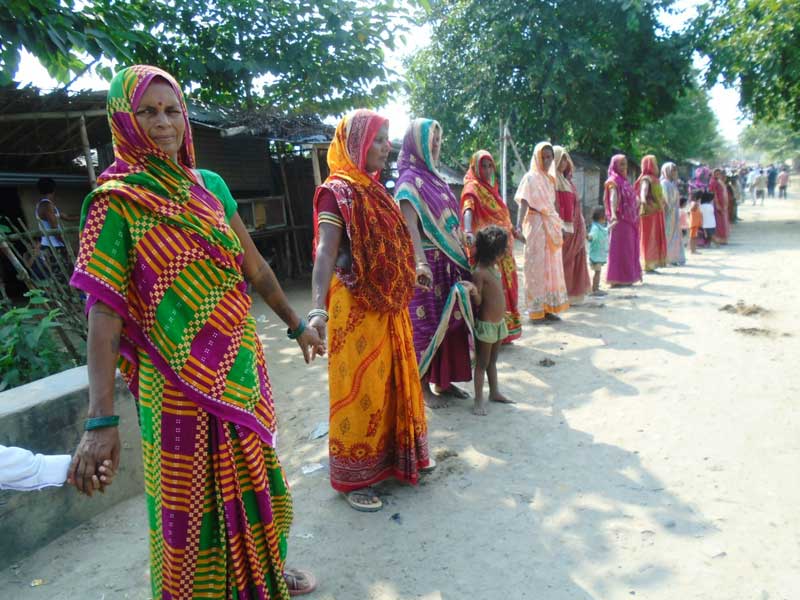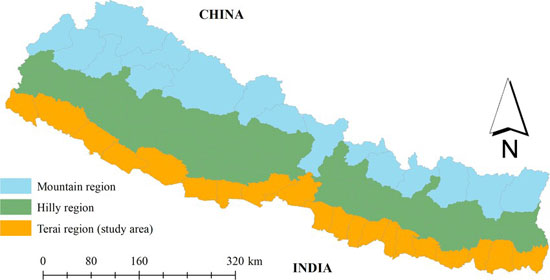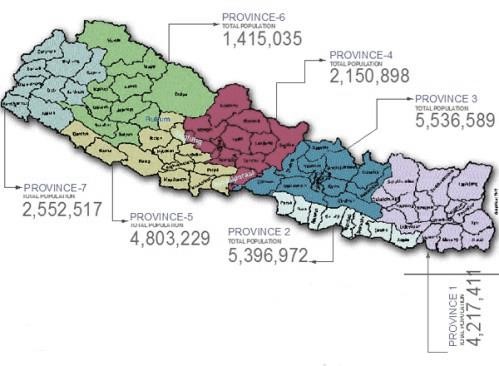The Constitution of Nepal: Controversies regarding Citizenship Rights and Political Representation in the Terai

Table of Contents
- A complex social and political context
- Citizenship Rights
- Territorial Organization and Political Representation
- The protests
- The aftermath
The Constitution of the Republic of Nepal was adopted in September 2015, amidst a climate of intense protests and controversy over many provisions contained in its text. After an eight-year period during which an Interim Constitution was in place, the passing of the new document was very significant, since it became the first democratically approved constitution in this country, drafted by a popularly elected Constitutional Assembly (CA). However, its adoption was quickly followed by demonstrations from ethnic groups based in the Terai region of Western Nepal. In their opinion the new constitution’s provisions on federalism, political representation, and citizenship rights directly and negatively affected their already marginalized status. The most relevant consequence of their discontent was the blockade of the frontiers with India, the economic consequences of which were immediately felt across Nepal in the form of fuel and supplies shortage. Moreover, violence escalated since the beginning of the protests, resulting in several deaths and injuries to both civilians and members of the police. This article aims to describe the reasons why the constitution sparked such discontent, but in order to do this, certain aspects of the Nepalese socio-political context must be clarified first.
A complex social and political context
Despite its relatively small territorial extent (147.181 km² to be precise, almost half the size of Italy), Nepal embraces a large number of castes, ethnicities, languages and religions. The National Population and Housing Census reported in 2011 the existence of 126 caste/ethnic groups, 123 mother tongues, and ten religions. To over-simplify, Nepal’s population can be divided into three groups according to their geographical origin: Pahadis in the Hills represent 43.01% of the total population; Madhesis or “plains people” living in the Terai region amount to 50.27%; and Mountain people to 6,73%.

Figure 1: Geographic map of Nepal
However, as it can be inferred from such a vast diversity, none of these constitutes a homogeneous group. As an example, within the hills’ population, a difference can be made between Parbatiyas (the dominant groups of the Hills) and Janjatis or “hill minorities” (indigenous nationalities), and between them and the Dalits (untouchables). The term Madhesi on the other hand, is often used to designate caste Hindus, Muslims, and certain ethnic groups (although some of them claim an independent identity). A distinction should be made nonetheless, between Madhesis and Tharus: while the former term usually refers to people living in eastern and central Terai, the latter refers to indigenous inhabitants of the Western part of the Terai region.
This highly complex social structure becomes even more entangled when the open border with India is added to the equation. The Terai region is in fact linked to its neighbouring country in such an inextricable way that Madhesis are almost culturally identical to Indians, which leads to their allegiance to the country to be under constant questioning by the Pahadis. The area is a source of persistent political tensions, as Madhesis feel “they have been treated like a colony of the hills, despite the fact that the Tarai is now home to 50 percent of Nepal’s population, most of its industry, and the great bulk of its agriculturally productive land, and despite the fact that the educational level and capabilities of many Madhesis is high”.
Moreover, Nepal’s political history has been marked by instability. Originally established as a Hindu monarchy, in 1996 Nepal became the scenario of a decade-long civil war that resulted in over 17.000 deaths and 100.000 forced displacements. The immediate detonator for the conflict was the lack of recognition of the Maoist party to participate in elections, but the movement gained wide support, especially in rural areas, due to its ability to articulate the needs and issues of a population that was largely marginalized. The lack of stability and internal struggles of the political establishment in Kathmandu also contributed to the persistence of the conflict. In 2005, a “monarchical coup” dissolved the government and suspended the Constitution. The subsequent interruption of international aid and massive popular protests forced the King to re-establish the Parliament, and to sign a Comprehensive Peace Agreement in 2006.
The new Parliament, with a Maoist Majority, abolished the Monarchy and adopted an Interim Constitution in 2007 that established a republican regime, and provided for the election of a Constituent Assembly, which would exercise parliamentary functions until the drafting of a new constitution. During the following seven years, the three major parties could not come to an agreement, primarily regarding the country’s territorial organization and the possibility to adopt a federal structure. This “deadlock” was finally overcome in September 2015, when parties reached an arrangement and decided to push forward a “fast-track Constitution”, arguing that the need for reconstruction after April’s earthquake called for this special procedure.
The document became highly contested in the weeks previous to its formal adoption, and the political process was accompanied by a series of protests that took their most violent form in the Terai region. The protests revolved around three main issues: citizenship rights, the new federal division and the rules for designing electoral constituencies.
Citizenship Rights
Article 11 of the Constitution establishes a difference between citizenship by descent and citizenship by naturalization. Citizens by descent are those who are born to a Nepalese mother and father, while children born to a Nepalese mother and foreign father can only access Nepalese citizenship by naturalization. The Constitution thus establishes different lineage rules for men and for women. While it is clearly stated that the child of a Nepalese woman and a foreign citizen shall be only eligible for naturalized citizenship, the same is not stipulated for the child of a Nepalese man and a foreign woman (as the latter is eligible for naturalized citizenship after marriage). This is in direct contradiction to article 9 of the Convention on the Elimination of All Forms of Discrimination Against Women (CEDAW).
The difference between naturalized citizens and citizens by descent becomes of the utmost relevance when a key issue is brought into consideration: only the latter can access a large number of public offices. As article 289 of the new constitutional text clearly expresses:"A person shall have acquired a citizenship by descent to be elected, nominated and appointed as the President, Vice-President, Prime Minister, Chief Justice, Speaker of the parliament, Chairperson of National Assembly, Head of the province, chief minister, speaker of Provincial Assembly and chief of security bodies".
Citizenship rights have been one of the most criticized features of the Constitution, especially in the Terai region, where the proximity to India means that many of its inhabitants would only be eligible for Nepali citizenship through naturalization, losing certain political rights. Another concern emerges as it can be inferred from article 11 (3) that citizenship by descent would only be acquired after reaching age majority. This provision could have consequences regarding statelessness, which happens to be a serious issue in Nepal, affecting over 4 million people. Statelessness in this country is a direct consequence of a legal system that has historically granted women different citizenship rights than those of men, limiting their ability to pass on Nepali citizenship to their children.
Territorial Organization and Political Representation
The Constitution established a new structure for the Nepalese State by differentiating federal, provincial and local levels of government. It is the middle level that deserves our attention, as the division of the country’s territory into provincial districts became the most contested element during the protests. According to the new territorial organization, seven provincial districts now compose Nepal’s political limits:

Figure 2: The 5 provincial districts in the new constitution.
The main issue was linked to the ethnic and caste diversity within the demarcated districts, with some voices raising claims in favor of ethnic-based divisions. More specifically, in the Terai Madhesis and Tharus put forward demands for two separate provinces in which each group would have a demographic majority. The 7 districts delimitated in the constitution meant that the population of the Terai is now part of 5 different provinces, which in turn translates into Madhesis and Tharus being minority groups within these provinces.
This impacts upon representation in the Legislative power: ethnic groups claimed that the Constitution reduced proportionality in comparison to the previous Interim Constitution of 2007, since proportional representation would be used to elect less than half of representatives of the lower chamber. Most of them would be appointed through a first-past-the-post system: one for each electoral district. And here another problem emerges: in the new Constitution electoral constituencies would be defined on the basis of both geography and population equally. This could mean that less populated constituencies of the Hills would be overrepresented in the lower chamber. Furthermore, the voting system for the higher chamber meant that the Madhesis would only be able to place 16 out of 59 members, leading to further claims of unproportionality.
The protests
The demonstrations had begun in August, but tensions escalated in September, when the protesters instituted a road blockade of the Birgunj checkpoint located on the Indian-Nepalese border, thus impeding the passage of petrol, medicine, gas and other fundamental supplies into Nepal. Since India is Nepal’s biggest commercial partner, accounting for more of 60% of this country’s foreign trade, the blockade had immediate consequences across the country. The cultural links uniting Madhesis to India resulted in the Nepalese government’s claims of an unofficial embargo by this country, among accusations of India’s economic support for the protesters.
India has been historically sympathetic to Madhesi demands, and has expressed concern over the constitutional process and its consequences for this particular group, while denying any involvement in the protests. Geopolitics entered the equation even further since China offered a solution for the shortages, by providing fuel supplies and infrastructure to open the borders with Tibet that had been closed by April’s earthquake. Hence, the internal conflict had relevant consequences on the influence of both of these large countries over Nepal.
The violent character of the protests and of the police response quickly raised international concern. A Human Rights Watch report entitled “Like we are not Nepali”, published in October 2015, portraits a detailed view of the events that by that time had already resulted in about 45 deaths:"There is, in short, compelling evidence of criminal attacks on defenseless police by protesters, and abundant evidence in several cases of serious crimes by police against protesters and bystanders, including disproportionate use of force and extrajudicial killings. In addition to the deaths, hundreds of people have been injured, some of them grievously". According to this report, the protests were most likely expected by the government, who passed a regulation allowing the Armed Police Forces to use lethal force, granting them immunity if any death occurred in the performance of their duties . Amnesty international also noted on the excessive use of force by police forces, while urging the government to ensure that the new constitution provides for full protection, respect and fulfilment of human rights.
The aftermath
In January 2016, two constitutional amendments were passed. The Constitution now recognizes Madhesis and Tharus as vulnerable populations in need of special protection in terms of social justice, and refers to their proportional inclusion in state bodies (Art. 42 and Art. 84) and includes population as the first criteria for delimiting electoral constituencies and geography as the second (Art. 286). The blockade of the Indian border was lifted in February 2016, but discontent lingered on and many voices were raised against what were perceived as insufficient and unilateral amendments.
The main problem, as Prashant Jha states, seems not to be about drafting or passing of constitutions, but of popular ownership. While the latest attempt at consolidating a foundational document marked a significant change with the past since it was carried out by a democratically elected Constitutional Assembly, the seemingly top-down manner through which the fast-track process was carried out worked against popular ownership. In a country as culturally, ethnically, and religiously diverse as Nepal, this is a crucial issue. Moreover, human rights concerns raised internationally by the content of the new constitutional text suggest that Nepal has not yet overcome certain traditionally imposed inequalities between its different social groups. Taking into account that Madhesis and Tharus together represent a large portion of the country’s population, the need for participatory processes that aim at increasing inclusiveness becomes fundamental.

